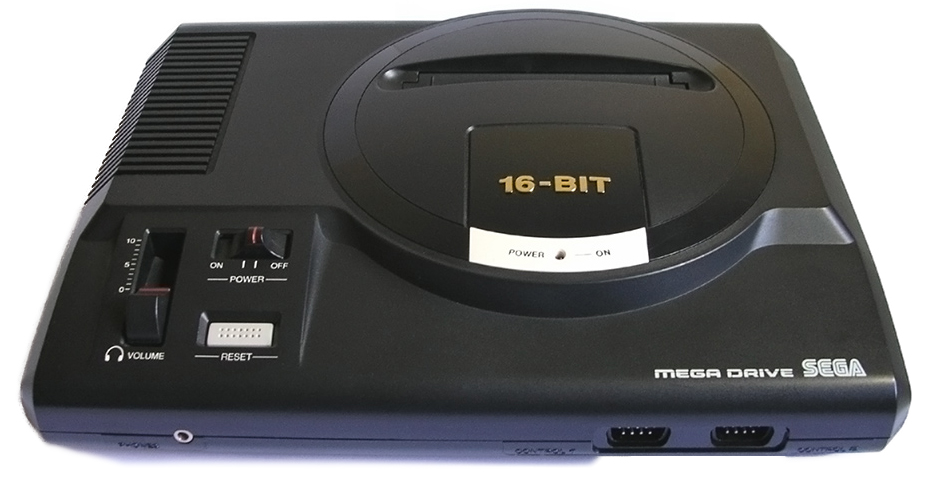
Mega Drive Console for High Quality Games
Who doesn’t love gaming? It is hard to find anyone who really doesn’t like to play game. So, it is the hottest topic in current era.
After the invention of personal computer, gaming becomes so popular that is near to a person. People who have a personal computer, he/she easily can buy a game on online store or physical store and can play game on his/her personal computer.
Though playing game of personal computer is fun but the real gamers are really freak. Most of them are not happy to playing game on personal computer only. Because playing game on personal computer sometime becomes irritated. So, they are looking for a gaming console to play their desire games.
For the gamers, in marketplace there are some companies whom are producing gaming console.Like, Xbox from Microsoft, Play Station from Sony, Nintendo Wii U. All of them are really popular in present situation.
Besides all of those console Mega Drive is also gaming console. It was so much popular in worldwide at the time it first come to the market and became much more popular on the regions those are the outside of North America.
History Behind Mega Drive:
Actually, the Mega Drive is called Sega Mega Drive. But in North America it called Sega Genesis as well as Super Game Boy also. The Super Game Boy named come from the later Super Aladdin Boy in South Korea. In 1988 the Super Aladdin Boy gaming console was developed by Sega. It was a cartridge based video game console.
Mega Drive is the third gaming home console from the Sega. After the SG-1000 which includes SG-1000 II and Mark III (also called the Sega Master System). In the development process the Mega Drive was also called the Sega Mark V, which was the codenamed of Mega Drive. But now it is become a part of fourth generation video gaming consoles.
Sega Drive had a software library system. For these, more than thousands of games released for this gaming system and store on software library. So, on that time, gamers didn’t buy game from market. The Mega Drive had built game compatibility at its time being.
The main competitors for Mega Drive was Nintendo’s Famicom (NES) and following on Super Famicom (SNES). Besides this, NEC’s TurboGrafx-16 (a personal computer engine in Japan), SNK’s Neo Geo, Atari Jaguar and other numerous number of home consoles and computers is always the biggest console wars of all the time.
Hardware Configuration:
Mega Drive also known as Sega Genesis is mainly a 16-bit home video game console. This gaming console builds on the technology that found in the Master System with adaptors and backwards compatible. Besides, it is upping its technical specifications that’s demanding more on gameplay, sound system and graphical interfaceso that, a number of numerous changes happened on the design of consoles that still continue.
The output Mega Drive sounds is in stereo mode and it can produce some clearer graphical views. All the Mega Drives have a top loading design like the cumbersome VCR-style cartridge loading from the Western NES that helps to removable controllers. From the day one of the console, the console can allow hardware expansions that is help for expand the configuration of the hardware system for revision versions.
In the time being of 1988, the time of its release it was the most powerful gaming console that surpassing the personal computer engine TurboGrafx-16. But the power optimization system was not surpassed until the 1990 when the Neo Geo was come in the gaming console marketplace.
Like to compare with the other home computer on that time, it was not that kind of powerful like the Sharp X6800 as know the Japan Exclusive Computer that released in 1987 or FM Towns which released later on 1989. But the Mega Drive was more powerful than other Western home computers in the late of 80s including the Amiga.
Technical Specifications:
The system master clock rate is 53.70 MHz in NTSC and 59.21MHz in PAL. The frame rate per cycle of master clock is 896,040 in NTSC and 1,067,040 in PAL, where per scanline in master clock is 3420.
Processor:
Main CPU:Motorola 68000
Clock rate: 7.670453 MHz (NTSC), 7.600489 MHz (PAL)
Instruction set: 16‑bit and 32‑bit CISC instructions
Data bus width: 32-bit internal, 16‑bit external
External data bus clock rate: 5 MHz (5 MB/s external data access bandwidth)
Arithmetic logic units: 16-bit data ALU, 32-bit address ALU (2x 16-bit ALU)
Sound CPU: Zilog Z80
Clock rate: 3.579545 MHz (NTSC), 3.546894 MHz (PAL)
Data bus width: 8‑bit
CPU instruction performance: 1.861363 MIPS (NTSC), 1.844386 MIPS (PAL)
68000 performance: 1.342329 MIPS (NTSC), 1.330086 MIPS (PAL)
Z80 performance: 0.519034 MIPS (NTSC), 0.5143 MIPS (PAL)
Sound:
FM sound chip: Yamaha YM2612, clocked at the 68000, clock speed (7.670453 MHz in NTSC, 7.600489 MHz in PAL)
PCM sampling quality: 8‑bit depth, 8–22 kHz sampling rate
IRQ interrupt capabilities: IRQ2 sound interrupt
PSG sound chip: Sega PSG (SN76496), clocked at the Z80 clock speed (3.579545 MHz in NTSC, 3.546894 MHz in PAL) and built into the VDP
Four audio channels: Three channels of pure square wave tones, and one noise channel
Graphics:
GPU: Sega 315‑5313 VDP (Yamaha YM7101)
Clock rate: 13.423294 MHz (NTSC), 13.300856 MHz (PAL)
Pixel clock rate: 6.711647 MHz (NTSC), 6.650428 MHz (PAL)
Internal data bus: 16-bit
External data buses: 16-bit CPU bus, 8/16-bit VRAM bus (Dual Port VRAM, 16-bit RAM/SAM, 8-bit RAM)
IRQ interrupt capabilities: IRQ6 VBlank interrupt, IRQ4 H‑Int (Horizontal Interrupt) scanline interrupt
Video Encoder DAC: Sony CXA1145 (NTSC/PAL)/ Fujitsu MB3514 (PAL)
Color burst clock frequency: 3.579545 MHz (NTSC), 4.433618 MHz (PAL)
Refresh rate: 59.92274 Hz (NTSC), 49.701459 Hz (PAL)
Progressive scan resolutions:
NTSC: 320×224, 256×224
PAL: 320×224, 256×224, 320×240, 256×240
Interlaced resolutions:
NTSC: 320×448, 256×448
PAL: 320×448, 256×448, 320×480, 256×480
Memory:
System RAM: 136 KB
Main RAM: 64 KB
VRAM: 64 KB
FPM DRAM: 64 KB
SAM buffer cache: 256 bytes
Audio RAM: 8 KB
VDP internal cache: 232 bytes
Sprite cache: 80 bytes
Cartridge memory: 512–8224 KB
ROM: 512 KB to 8 MB
SRAM: 8 KB to 32 KB
Bandwidth:
Main RAM: 10.526314 MB/s (16-bit, 5.263157 MHz)
VRAM: 8–11.764705 MB/s (NTSC), 8–8.333333 MB/s (PAL)
Audio RAM: 3.030303 MB/s (8-bit, 3.030303 MHz)
Cartridge ROM bandwidth: 10 MB/s
Models:
Mega Drive:
The main Mega Drive measures 28cm x 21.2cm x 7cm. Its top unit divided into two parts or components. One is a circular emboss which carries the cartridge slot and other one is tagline. But in the later improvise version the tagline was omitted. There also a control panel, which containing the power and reset options and for the headphones jack there is a volume slider. Though the headphone jack was used for stereo sound the audio output system in the original model was mono using A/V port. So, the A/V port convert the sound system slightly.
But in different country there is a little bit differences in model. Like in Asian, Japanese and South Korean models there is cartridge locking system that prevents cartridges for being removed while the power button is on. In the improvise version the TradeMark security system is added also. This security ensured that, Mega Drive became an intellectual property globally.
Mega Drive 2:
But in later 1993 the Mega Drive 2 was released. This one was the most cost reduced design from the very first one. It measurement was 22cm x 21.2cm x 5.9 cm.
In this model the stereo headphone jacks were being removed. Instead of, there was a favor of output through a redesigned A/V port which includes 9 pins.
But a major problem of Mega Drive 2 was lacks a Z80, actually Zilog Z80. Z80 was the most important chip on this time for the Mega Drive 2. Because the lacking of this chip many games that would run on Mega Drive 2 was no sound at all. But in the later revision versions, Z80 integrated into a custom ASIC that incorporated with major chip components.
Genesis 3:
In 1998 a small version of Mega Drive released only for American market. This time it was called the Genesis 3. This version of Mega Drive is released by Majesco. In this version, all kind of bugs including memory controller bugs were being fixed like unplayable some games and the Sega CD as well as 32X unusable rendering problems.
Some Popular Games of Mega Drive:
There were very popular games which ran on Mega Drive at time of it was released. Some of are, Phantasy Star IV, Shining Force II, Gunstar Heroes, The Revenge of Shinobi, Ghouls 'n Ghosts.
It is hardly that the Mega Drive was the most successful video gaming console on its time era. This gaming console was sold over 40 million of unit internationally including United States, Japan, Western Europe and Brazil. Though Mega Drive was an analogue machine type console but it is not totally ancient or nostalgic or dead. It will be still fun to play the most popular games of Mega Drive with friends and family with this console. It costs also exciting and demanding experience that really remembering.
See full specifications and price here: https://ebgames.com.au/loot-220618-Sega-Mega-Drive-Classic-Console-Loot
